Day 2 :
Keynote Forum
Massimo Guarnieri
University of Padua, Italy
Keynote: A selective hybrid stochastic approach to proton exchange membrane fuel cells multi parameter identification
Time : 09:00-09:40

Biography:
Massimo Guarnieri completed his MS degree in Electrical Engineering at University of Padua, Italy, in 1979 and his PhD degree in Electrical Science in Rome in 1987. He joined Italian National Council of Research in 1982 and University of Padua in 1983, where he has been Full Professor of Electrical Engineering since 2000. Initially, he worked on devices for thermonuclear fusion research. He later centered his research interests on electromagnetic computation. In the last ten years, he has been involved in modeling and designing electrochemical storage devices. He is interested in the history of technology and science. He is a Columnist and a member of the Editorial Board of IEEE Industrial Electronics Magazine.
Abstract:
The characterization of fuel cells involves a number of physical parameters which are important for quantifying and comparing the performance of the materials and for trimming analytical and numerical models. Careful ex situ measurements of such parameters can be performed by means of a number of diagnostic techniques, whose results are however not completely consistent with fuel cell operation due to several side effect. Conversely, in situ measurements can provide meaningful operational values, but a very few techniques are available to determine a limited number of parameters. An alternative consists in multiple parameter identification from multiple fundamental measurements performed in different conditions, e.g., at different temperature, pressure, concentration, and humidification. If there is only one unknown parameter, the solution is easy, requiring just a statistical interpolating technique. In the case of multiple unknown parameters, the problem becomes increasingly challenging with the number of parameters, as duplicity problem emerges, i.e., several groups of parameters may lead to the same performance (e.g. polarization curve). A number of numerical tools have been proposed to face this kind of problems. Stochastic mathematical models have been applied to the analysis of fuel cells for more than ten years, but typically to specific problems and by means of semi-empirical models, with an increased number of articles published in the last years. We present an original formulation that makes use of an accurate zero-dimensional multi-physical model of a polymer electrolyte membrane fuel cell and of two cooperating stochastic algorithms, particle swarm optimization (PSO) and differential evolution (DE), that proved to be successful in extracting multiple material parameters (exchange current density, mass transfer coefficient, diffusivity, conductivity, and activation barriers) from the experimental data of multiple polarization curves (i.e., in situ measurements) under controlled temperature, gas back pressure and humidification. The method is suitable for application in other fields where fitting of multiphysics nonlinear models is involved.

Recent Publications:
1. Alotto P., Guarnieri M., Moro F., “Redox Flow Batteries for the storage of renewable energy: a review”, Renewable & Sustainable Energy Reviews 29 (2014): 325-335.
2. Guarnieri M., Alotto P., Moro F., “Modeling the Performance of Hydrogen-Oxygen Unitized Regenerative Proton Exchange Membrane Fuel Cells for Energy Storage”, Journal of Power Sources 297, (11), (2015): 23-32.
3. Guarnieri M., Negro E., Di Noto V., Alotto P., “A Selective Hybrid Stochastic Strategy for Fuel-Cell Multi-Parameter Identification”, Journal of Power Sources 332 (2016): 249–264.
4. Spagnuolo G., Petrone G., Mattavelli P., Guarnieri M., “Vanadium Redox Flow Batteries: Potentials and Challenges of an Emerging Storage Technology”, IEEE Industrial Electronics Magazine 10 (4), (2016): 20-31.
5. Maggiolo D., Picano F., Guarnieri M., “Flow and dispersion in anisotropic porous media: a Lattice-Boltzmann study”, Physics of Fluids, 28 (10), (2016): 102001.
6. Moro F., Trovò A., Bortolin S., Del Col D., Guarnieri M., “An alternative low-loss stack architecture for vanadium redox flow battery: comparative assessment”, Journal of Power Sources, 340 (2017)
Keynote Forum
Arunkumar Jayakumar
Auckland University of Technology, New Zealand
Keynote: Measurement techniques and related challenges involved in the gas diffusion electrode characterization of PEM fuel cell stack
Time : 09:40-10:20

Biography:
Arunkumar Jayakumar is a Research Fellow at Auckland University of Technology, New Zealand. He has 10 years of experience in PEM fuel cell stacks and systems. He has worked with wide range of Ballard’s stack namely, Nexa, 1020 ACS and 1310 WCS. His research activities include PEM fuel cell stacks and systems, sensor, electric vehicles, material characterization and hydrogen energy. His research is currently funded by the IBTec, AUT. He is a member of the IPENZ, IEEE and ASME.
Abstract:
Proton Exchange Membrane (PEM) fuel cells are emerging as a commercially viable alternative for the production of clean and reliable energy. The Membrane Electrode Assembly (MEA) is the principal component of a PEM fuel cell. The operation of the fuel cell involves the hydrogen (fuel) being supplied to the anode and oxygen/air being fed to the cathode. At the anode region, the hydrogen is oxidized to protons and electrons the membrane allows protons to pass through it while the electrons are forced to travel through the external circuit. At the cathode, the oxidant is reduced and in this way, electricity is drawn from the cell. Figure 1 illustrates a single PEM cell, indicating various sub-components and the charge transfer. PEM fuel cell performance is meticulously correlated to the gas diffusion electrodes (GDE). GDE in a PEM fuel cell stack usually comprises of the catalyst layer and the gas diffusion layer and the present paper provides a comprehensive measurement issues pertaining to the characterization of GDE. The various GDE characterizations (in situ and ex situ) and the corresponding instrument involved in the present paper is listed as follows in the table 1. Gas diffusion electrode characterization is complex, which involves the existence of both solid and fluid phases, and due to the random morphology of the diffusion electrode. However, these characteristics are very much significant to validate its role in the PEM fuel cell stack. The measuring instrument play a significant role in maximizing the efficiency and durability of the PEM fuel cell stack components; because it is impossible to control the operating parameters without proper measurement. However, the measurement strategies involved in the GDE components is highly complex due to the non-linear behaviour during the PEM fuel cell operation. In the present paper, a holistic insight on all these measurement instruments and related challenges will be comprehensively dealt.
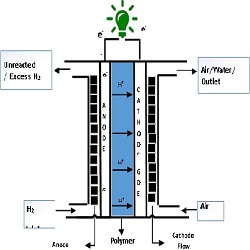
Figure 1: A plan of PEMFC single cell, indicating electron and ion transfer
Recent Publications:
1. Fernández, J.L., et al., Optimization Of “Wired” Enzyme O2â€Electroreduction Catalyst Compositions by Scanning Electrochemical Microscopy. Angewandte Chemie International Edition, 2004. 43(46): p. 6355-6357.
2. Yuhashi, N., et al., Development of a novel glucose enzyme fuel cell system employing protein engineered PQQ glucose dehydrogenase. Biosensors and bioelectronics, 2005. 20(10): p. 2145-2150.
3. Cosnier, S., A. Le Goff, and M. Holzinger, Towards glucose biofuel cells implanted in human body for powering artificial organs. Electrochemistry Communications, 2014. 38: p. 19-23.
- Classification of Fuel Cells| Applications of Fuel Cells| Hydrogen Energy| Super Capacitors vs. Battery| Various Energy Materials
Location: Olimpica 2

Chair
Arunkumar Jayakumar
Auckland University of Technology, New Zealand
Session Introduction
Nai-Chien Shih
Ming Dao University, Taiwan
Title: Development of a pure oxygen and pure hydrogen fuel cell generator for small under water vehicles

Biography:
Nai-Chein Shih completed his PhD from University of Cranfi eld, UK. He is now the Chairman of Chinese Academy of Science and Education, 2017 – Present. He
has his specializations in Hydrogen technology and fuel cell power generation system (PLC control and IC control), Business management and energy product
engineering and development.
Abstract:
This study has developed and tested a 1-KW water cooled Proton Exchange Membrane Fuel Cell Generator (PEMFCG) system. This system that provides 1 KW of electric power steadily at ~60°C has been tested under software monitory online via pure H2 and O2 recycling. The PEMFCG is equipped with two sets of gas-liquid dual-purpose compressors and H2/O2/H2O vapor separators. The water discharged from the separators is being used for continuous power generation. The PEMFCG will be disassembled and then reassembled in an Underwater Vehicle (UV) prototype for performance retest under actual operating environment.
Serge Zhuiykov
Ghent University Global Campus, South Korea
Title: Supercapacitor with improved performance based on ALD-developed two-dimensional WO3/TiO2 heterojunction

Biography:
Serge Zhuiykov received his PhD in Materials Science and Engineering in 1991. He has more than 25 years of combined academic and industrial experience working at different universities in Australia, Japan, Korea and Europe and industrial environments. Since 2015, he is a Senior Full Professor in Department of Applied Analytical & Physical Chemistry of Ghent University Global Campus, Korea and a Director of Environmental & Energy Research Center. His research interests include “The development, design and fabrication of new two-dimensional nanomaterials for solid-state environmental sensors and other advanced functional devices”. He has published more than 200 peer-reviewed scientific publications including two monographs in 2007 and 2014, respectively. He is a recipient of the 2007, 2011, 2013 Australian Academy of Science/Japan Society for Promotion of Science and 2010 Australian Government Endeavour Executive Awards for his work on Advanced Nanomaterials.
Abstract:
Supercapacitors (SCs) also known as, electrochemical capacitors, have been considered as one of the potential energy storage systems in addition to batteries, due to their high power density, fast charging/discharging and long-term cycling stability. Many metal oxide including RuO2, MnO2, Co3O4, NiO, SnO2, TiO2, WO3, perovskites, ferrites, etc., have been applied as alternative materials for supercapacitor electrodes. Among these metal oxides, TiO2 and WO3 are two of the most versatile materials and have been widely applied in electronics, photocatalysts, sensors and electrochromism. In the past, we demonstrated high capabilities of monolayers of TiO2 and WO3 developed by atomic layer deposition (ALD). It is appeared to indicate that both of them are promising candidate materials for high-performance SC electrodes. Moreover, nanostructured WO3/TiO2 heterojunction was highly investigated in various applications, especially in photochemistry and photo-electrochemistry, and has already exhibited excellent electrochemical properties. However, atomically-thin two-dimensional (2D) WO3/TiO2 heterojunction have not yet been considered and investigated as the electrode material in SCs. Therefore, in this study, we demonstrate for the first time capabilities of the 2D WO3/TiO2 heterojunction developed by ALD technique for SC electrodes. CV curves of three 2D nanomaterials at scan rate of 50 mV s-1 are presented in figure below. The ALD-developed WO3/TiO2 heterojunction has a uniform thickness of ~12 nm with a relative rough surface. The SC electrode based on this heterojunction has shown excellent super-capacitive behavior with high specific capacitance up to 625.53 F g-1 at the current density of 1 A g-1 and remarkable long-term stability of 97.98 % over 2000 cycles.
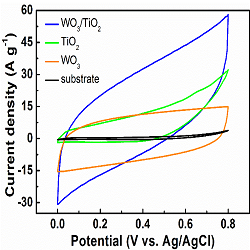
Recent Publications:
1. Lockhande C D et al (2011) Metal oxide thin film based supercapacitors. Curr. Appl. Phys. 11:255-270.
2. Bavykin D V et al (2006) Protonated titanates and TiO2 nanostructured materials: Synthesis, properties, and applications Adv. Mater. 18:2807-2824.
3. Zheng H et al (2011) Nanostructured tungsten oxide - Properties, synthesis, and applications. Adv. Funct. Mater. 21:2175-2196.
4. Zhuiykov S et al (2017) Wafer-scale fabrication of conformal atomic-layered TiO2 by atomic layer deposition using tetrakis (dimethylamino) titanium and H2O precursors. Mater. Des. 120:99-108.
5. Zhuiykov S et al (2017) Atomic layer deposition-enabled single layer of tungsten trioxide across a large area. Appl. Mater. Today 6:44-53.
Mamta Kumari
Homi Bhabha National Institute, India
Title: Fuel cell performance of SPEEK-PEG-PWA composite membrane

Biography:
Mamta Kumari is currently working as a Senior Research Fellow in the Membrane Development Section of Chemical Engineering Group at Homi Bhabha National Institute, India. She has expertise in the field of development of solid polymer electrolyte for electrochemical applications, e.g., fuel cells. Her studies are in the field of development of structurally modified membranes with high conductivity.
Abstract:
Proton exchange membrane fuel cell (PEMFC) is promising technology for clean and efficient power generation in the 21st century. Currently perfluorinated membranes are used as electrolyte that have high cost and complicated synthesis process which limits the commercialization of the PEMFC. Hydrocarbon polymers are good alternative for membranes and during last few decades research has been concentrated on that. The present work focuses on the development of composite membrane by using a thermoplastic polymer, partially sulfonated polyether ether ketone (SPEEK) and polyethylene glycol (PEG) as cross-linker along with varying amount of phosphotungstic acid (PWA) as an inorganic additive. The membranes are prepared using sulfonated PEEK with an ion exchange capacity of 2 meq/g and 33% of PEG having molecular weight of 600 Da was used as cross linker, the amount of PWA was varied from 5 to 50%. Among the various concentration of PWA in membranes, the 10 wt% PWA gave highest conductivity (90 mS/cm), less swelling and good stability in water up to 60ºC. The fuel cell performance of these membranes was measured using a 25 cm2 membrane electrode assembly made using commercial carbon paper based electrode (0.2 mg/cm2 Pt loading). The cell performance tests were carried out (H2/O2 at 2 bar pressure) at 30 and 60ºC (Figure 1). The maximum power density obtained at 30ºC was 75 mW/cm2 at current density of 200 mA/cm2 and voltage 375 mV which increased at 60ºC to 173 mW/cm2 at current density of 440 mA/cm2 and voltage 400 mV. The cell gave stable performance after running for 40 hours at its maximum power. The present membrane performance is comparable with the reported value for commercial membranes (power density of 360 mW/cm2 to 420 mW/cm2 at 600 mV and 80ºC). Hence, the SPEEK-PEG-PWA membranes can be an alternative solid polymer electrolyte for fuel cell.
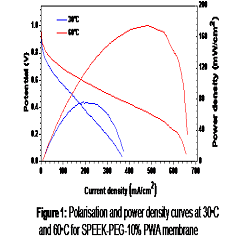
Recent Publications:
1. Yee R S L, Rozendal R A, Zhang K, Ladewig B P (2012) Cost effective cation exchange membranes: A review. Chemical Engineering Research and Design 90:950-959.
2. Sambandam S, Ramani V (2007) SPEEK/functionalized silica composite membranes for polymer electrolyte fuel cells. Journal of Power Sources 170:259-267.
3. Moreno G N, Molina C M, Gervasio D, Robles P F J (2015) Approaches to polymer electrolyte membrane fuel cells (PEMFCs) and their cost. Renewable and Sustainable Energy Reviews 52:897-906.
4. Lee H K, Chu Y J, Kim R A, Nahm S K, Kim J C, Yoo J D (2013) Densely sulfonated block copolymer composite membranes containing phosphotungstic acid for fuel cell membranes. Journal of Membrane Science 434:35-43.
5. Colicchio I, Wen F, Keul Helmut, Simon U, Moeller M (2009) Sulfonated poly(ether ether ketone)-silica membrane doped with phosphotungstic acid. Morphology and proton conductivity. Journal of Membrane Science 326:45-57
Mohamed A Abu-Saied
Advanced Technologies and New Materials Research Institute, Egypt
Title: Preparation and characterization of PVC-SP(ST-co-AN) membranes for proton exchange membrane fuel cell applications

Biography:
Mohamed A. Abu-Saied has his expertise in polyelectrolyte membranes for fuel cell Application. His open and contextual evaluation (preparation and characterization) of polymer polyelectrolyte membranes for fuel cell application. He has built this model after years of experience in research, evaluation, teaching and administration in education institutions.
Abstract:
Polyvinyl chloride-sulfonated poly(styrene-co-acrylonitrile) [PVC-SP(ST-co-AN)] for proton exchange membrane fuel cell have been prepared through two steps. The first step was preparation of sulfonated poly(styrene-co-acrylonitrile) [SP(ST-co-AN)] by using solution polymerization and KPS as initiator and sulfonated the product of poly(styrene-co-acrylonitrile) [P(ST-co-AN)] which reacts with sulfuric acid. The second step was mixing polyvinyl chloride (PVC) and sulfonated poly(styrene-co-acrylonitrile) [SP(ST-co-AN)] with different ratio. Essential characters required for polyelectrolyte fuel cell membrane especially ionic conductivity, methanol permeability, ion exchange capacity (IEC), thermal stability and high mechanical properties were investigated. Ion exchange capacity increase with increase sulfonated poly(styrene-co-acrylonitrile) [SP(ST-co-AN)]. The methanol permeability of membrane which consider as essential character for PEM fuel cell application was found lower than of nafion. The obtained results are very promising and opening new area for conducting further investigations considering the very low price of polyvinyl chloride compared to nafion.

Figure 1: Glass diffusion cell for methanol permeability measurements.
Recent Publications:
1. Harper C (2009) The neuropathology of alcohol-related braindamage. Alcohol Alcohol 44:136-140.
2. Zhu Y, Chen H, He C (2011) J Polym Res 18:1409
3. Mohy Eldin MS, Elzatahry AA, El-Khatib KM, Hassan EA, ElSabbah MM, Abu-Saied MA (2011) J Appl Polym Sci 119:120
4. Abu-SaiedMA,ElzatahryAA,El-KhatibKM,HassanEA,El-Sabbah MM, Drioli E, Mohy Eldin MS (2012) J Appl Polym Sci 123:3710
5. Mohy Eldin MS, Abu-Saied MA, Elzatahry AA, El-Khatib KM, Hassan EA, El-Sabbah MM (2011) Int J Electrochem Sci 6:5417
6. Wycisk R, Trochimczuk WM (1991) J Appl Polym Sci 43:1727
7. Mohammadi T, Skylls-Kazacos M (1995) J Membr Sci 98:77
8. Elkady MF, Abu-Saied MA, Abdel Rahman AM, Soliman EA, ElzatahryAA,YossefME,MohyEldinMS(2011)Desalination279:152
9. Kim M, Saito K (1999) React Funct Polym 40:275
Arunkumar Jayakumar
Auckland University of Technology, New Zealand
Title: The potential of micro-fuel cells to power the pacemaker-A critical assessment on material selection

Biography:
Arunkumar Jayakumar is a Research Fellow at Auckland University of Technology, New Zealand. He has 10 years of experience in PEM fuel cell stacks and systems. He has worked with wide range of Ballard’s stack namely, Nexa, 1020 ACS and 1310 WCS. His research activities include PEM fuel cell stacks and systems, sensor, electric vehicles, material characterization and hydrogen energy. His research is currently funded by the IBTec, AUT. He is a member of the IPENZ, IEEE and ASME.
Abstract:
Fuel cells are one of the efficient energy systems which convert the chemical energy of the fuel directly into the electrical energy. The greatest advantage of a fuel cell is its potential to be used for wide range of applications starting from high power vehicles to low power Implantable medical devices (IMDs). IMDs can be classified into two categories namely functional assisted devices and in-vivo measurements devices. Among these two devices, the role of pacemakers is very crucial as they require reliable power. Conventional, pacemakers are powered by lithium-ion batteries that need to be replaced from time to time which result in the increase in cost and complexity as well severe inconvenience to the patients. A glucose fuel cell (GFC) which is a subset of conventional polymer electrolyte membrane fuel cells (using hydrogen or alcohols as fuels) that oxidizes glucose and reduces oxygen to give electric energy. Since, glucose and oxygen are both present and continuously replenished in physiological fluids by the metabolism, this revolutionary approach is theoretically able to provide enough energy along the patient lifetime without any need of battery replacements. However, appropriate material selection is a critical factor in the design of these kind of fuel cells. In the present paper a holistic assessment on various material considering various factors such as bio-compatibility, strength to weigh ratio and other desirable characteristics inline to pacemaker design benchmarks are studied.
Recent Publications:
1. Fernández, J.L., et al., Optimization Of “Wired” Enzyme O2â€Electroreduction Catalyst Compositions by Scanning Electrochemical Microscopy. Angewandte Chemie International Edition, 2004. 43(46): p. 6355-6357.
2. Yuhashi, N., et al., Development of a novel glucose enzyme fuel cell system employing protein engineered PQQ glucose dehydrogenase. Biosensors and bioelectronics, 2005. 20(10): p. 2145-2150.
Renato Pelosato
Politecnico di Milano, Italy
Title: Doping strategies in NdBaCo2 O5+δ layered perovskites cathodes for IT-SOFCs

Biography:
Renato Pelosato had his degree in Chemistry at the Pavia University in 1999, and PhD in Materials Engineering at Politecnico di Milano in 2006. Since 2001, he is working on advanced ceramic materials for application in solid oxide fuel cells. Particularly he is devoted to the synthesis of materials using different synthetic routes (solid state reactive firing, wet chemical methods). In his career, he acquired interest in and knowledge on the structural, microstructural and physico-chemical characterization of ceramic materials. He is author of more than 40 papers published in peer-reviewed International Journals.
Abstract:
Co-based layered perovskites (LnBaCo2O5+d Ln=Lanthanides or Y) have been recently proposed as cathode materials for IT-SOFCS. These compounds crystallize in a double perovskite structure (LnCoO3-δ–BaCoO3-δ), where Ln and Ba ions sit on alternated single perovskite layers. Pr, Nd and Gd based compounds show the best performance, likely due to their optimum ion size. Recently, chemical modifications like cation deficiency and Co substitution have gained interest as a way to tailor the defect chemistry of these materials. The effect of Fe-doping on the B-site and of Ba deficiency on the A-site has been investigated. XRD, TG-DTA, ICP-MS and cerimetric titrations were performed to assess the phase composition, crystal structure, chemical composition and oxygen content. The electrochemical properties were investigated via 4-probe electrical conductivity measurements and electrochemical impedance spectroscopy on symmetrical cells with GDC electrolyte. All the compounds show high total electrical conductivity (between 400 and 600 S/cm at 700°C). A tenfold decrease of the area specific resistance is observed at increasing Ba deficiency to 10%. Detailed equivalent circuit analysis reveals that the effect of Ba is associated with a promotion of the bulk diffusion steps at high frequency. On the other hand, iron substitution triggers a structural change from orthorhombic to tetragonal, and lowers the electrical conductivity. The compound with 20% of iron shows the lowest polarization resistance (0.17 Ω*cm2 at 700°C). The ORR mechanism investigated by ECM and physical 1D modeling shows that the first electronation of the oxygen atom on the MIEC surface and the bulk diffusion of the oxygen vacancies in the MIEC lattice are the rate determining steps.
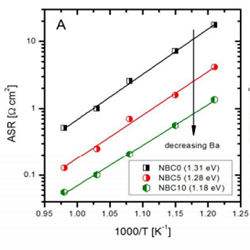
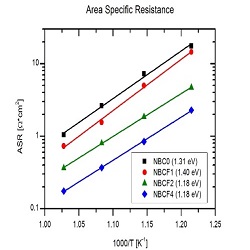
Figure 1: ASR of NBC material in symmetric cells with GDC electrolyte. Effect of increasing Ba deficiency (left) and increasing Iron doping (right)
Recent Publications:
1. A. Tarancón, S. J. Skinner, R. J. Chater, F. Hernández-Ramírez and J. A. Kilner, Journal of Materials Chemistry, 2007, 17, 3175. http://dx.doi.org/10.1039/b704320a
2. R. Pelosato, G. Cordaro, D. Stucchi, C. Cristiani and G. Dotelli, Journal of Power Sources, 2015, 298, 46. http://dx.doi.org/10.1016/j.jpowsour.2015.08.034
3. S. Pang, X. Jiang, X. Li, Q. Wang, Z. Su, J. Power Sources, 204 (2012) 53-59. http://dx.doi.org/10.1016/j.jpowsour.2012.01.034
4. F. Jin, H. Xu, W. Long, Y. Shen, T. He, J. Power Sources 2013, 243, 10. http://dx.doi.org/10.1016/j.jpowsour.2013.05.187
5. A. Donazzi, R. Pelosato, G. Cordaro, D. Stucchi, C. Cristiani, G. Dotelli, I.N. Sora, Electrochim. Acta, 182 (2015) 573-587. http://dx.doi.org/10.1016/j.electacta.2015.09.117
Giovanni Dotelli
Politecnico di Milano, Italy
Title: Graphene oxide membranes as alternative electrolytes for PEM fuel cells

Biography:
Giovanni Dotelli had his degree in Chemical Engineering at the Politecnico di Milano in 1989, and PhD in Materials Engineering at Politecnico di Milano in 1993. He is Associate Professor of Materials Science and Head of the Laboratory of Materials for Energy and Environment (Mat4En2) at the Dept. of Chemistry, Materials and Chemical Engineering “G.Natta” of the Politecnico di Milano. His research interests range from materials for fuel cells and environmental applications to sustainability assessment of industrial processes. He is author of more than 120 papers published in peer-reviewed international journals and conference proceedings.
Abstract:
Preliminary results about the use of a graphene oxide membrane as a possible alternative electrolyte to proton exchange membranes in Polymer Electrolyte Membrane Fuel Cells (PEMFCs) are reported. The key component of a PEMFC is the ionomer electrolyte, typically Nafion, due to its high proton conductivity in standard operating conditions, good mechanical properties and its effectiveness as gas separator. However, Nafion limits fuel cell operating temperature, reduces its conductivity upon dehydration and suffers shrinkage and swelling if water content changes significantly. An interesting alternative aiming to enhance FC efficiency and to overcome drawbacks related to Nafion employment could be represented by graphene oxide (GO). GO membranes have been found impermeable to many gases, whilst allowing permeation of water and minimizing fuel crossover. Some works report the use of GO in composite membranes with known proton conductors polymers such as Nafion, SPEEK, PBI and PVA. We synthesized and characterized a pure GO membrane as self-standing electrolytic membrane. A uniform self-assembled membrane was obtained and morphologically characterized by SEM, TGA and FT-IR analysis (Figure 1). A homogeneous surface and the presence of functional groups, i.e. hydroxyl, epoxy oxygen and carboxyl groups, which should guarantee proper proton conductivity, was achieved. A thickness of around 2 μm was measured. Since thickness is strongly related to initial GO solution concentration, other experiments are going to be done in order to increase it. Proton conductivity of the prepared membrane was determined by using impedance spectroscopy in the frequency range 1 MHz-1 Hz with an AC amplitude of 500 mV. A value of 0.008 S/cm was found at 20°C and anhydrous conditions. This is a very promising result since at the same operating conditions Nafion 212 shows a conductivity of almost one magnitude lower. Measurement at different temperatures and relative humidities, as well as in situ electrical tests, are in progress.
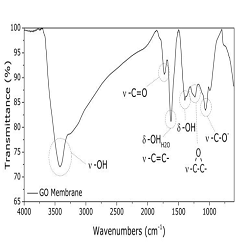
Figure 1: FT-IR spectrum of the GO self-standing membrane
Recent Publications:
1. Sansotera M, Gola M, Dotelli G, Navarrini W (2007). Chapter 7: The Role of Perfluoropolyethers in the Development of Polymeric Proton Exchange Membrane Fuel Cells. RSC Polymer Chemistry Series 24:158-178.
2. Li Q, He R, Jensen J O, Bjerrum N J (2003). Approaches and Recent Development of Polymer Electrolyte Membranes for Fuel Cells Operating above 100 °C. Chem. Mater. 15:4896-4915.
3. Nair R R, Wu H A, Jayaram P N, Grigorieva I V, Geim A K (2012). Unimpeded Permeation of Water Through Helium-Leak-Tight Graphene-Based Membranes. Science 335:442-444.
4. Bayer T, Bishop S R, Nishihara M, Sasaki K, Lyth S M (2014). Characterization of a graphene oxide membrane fuel cell. J. Power Sources 272:239-247.
5. Changyan X, Xiaomei S, An J, Lina S, Chen Z, Yunqi C (2015). Fabrication and Characteristics of Reduced Graphene Oxide Produced with Different Green Reductants. Plos One 10 12:1-15.
Yuan-Lung Hsu
National Taiwan University, Taiwan
Title: Development of a Bi-Cell proton exchange membrane fuel cell with optimized groovedesigned piezoelectric actuator

Biography:
Yuan-Lung Hsu received his BS and MS degree from National Kaohsiung University of Applied Sciences in 2010 and 2013, respectively. He is currently a PhD candidate in the Department of Mechanical Engineering, National Taiwan University, Taiwan. His research focuses on the development of piezoelectric actuators application in PEMFC.
Abstract:
This study develops an air-breathing pump driven by a piezoelectric actuator to provide oxygen for a proton exchange membrane fuel cell (PEMFC) stack. A groove-designed PZT actuator enclosed with poly-di-methyl-siloxane (PDMS) can reduce uneven air feeding. This actuator can also improve the performance of both sides of a bi-cell, with only a 0.7% difference in the open-circuit voltage under the PZT actuator within a PDMS diaphragm (PZT-PDMS combination) with 30 min curing time, one side of the single cell had an open-circuit voltage of 0.989 V. We combined the permanent magnets with piezoelectric actuator. As the result, the three air-breathing pumps of the bi-cell stack are driven by only one piezoelectric actuator through the magnetic force between magnets. The design of the bi-cell stack enables the air-breathing pump to provide sufficient oxygen for both single cells simultaneously. According to the analysis of computational fluid dynamics, when the nozzle and diffuser of the air-breathing pump have aspect ratio 13.13, diffuser angle (θ) of 15°, and channel opening width (D) of 1.0 mm, the air flow uniformly distribute over inside of the pump, and then it helps stable reaction between oxygen and membrane electrode assembly (MEA). This aspect ratio is chosen to apply on the stack. When both the PZTmag and the PDMSmag used a magnet with a 6 mm diameter and 1 mm thinness, the maximum amplitude of 87 μm was produced under operating conditions of 70 Hz and 40 Vrms, and the power consumption was 0.03 W. The resulting maximum net power density of the bi-cell PZTmag–PEMFC stack was 0.1925 W cm-2, the proposed PEMFC has a net power density that is 20% more than that of a three bi-cell PZT-PEMFC reported in previous research (Ma, 2013), with 68% and 76% less volume and weight, respectively.
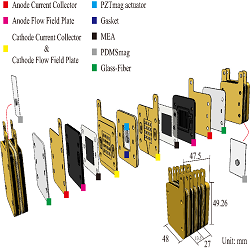
Figure 1: The schematic of the Bi-cell PZTmag-PEMFC stack.
Recent Publication:
1. D. Fuard, T. Tzvetkova-Chevolleau, S. Decossas, P. Tracqui, P. Schiavone (2008) Optimization of poly-di-methyl-siloxane (PDMS) substrates for studying cellular adhesion and motility. Microelectronic Engineering 85:1289-1293.
2. A. Ullmann (1998) The piezoelectric valve-less pump—performance enhancement analysis. Sens. Actuators A: Phys. 69:97-105.
3. H.K. Ma, S.H. Huang, B.R. Chen, L.W. Cheng, J (2008) Numerical study of a novel micro-diaphragm flow channel with piezoelectric device for proton exchange membrane fuel cells. Power Sources 180:402-409.
4. H.K. Ma, S.H. Huang, J.S. Wang, C.G. Hou, C.C. Yu, B.R. Chen, J (2010) Experimental study of a novel piezoelectric proton exchange membrane fuel cell with nozzle and diffuser. Power Sources 195:1393-1400.
5. H.K. Ma, H.M. Cheng, W.Y. Cheng, F.M. Fang, W.F. Luo, J (2013) Development of a piezoelectric proton exchange membrane fuel cell stack (PZT-Stack). Power Sources 240:314-322.
Po-Ching Hsu
National Taiwan University, Taiwan
Title: Magnetically driven piezoelectric proton exchange membrane fuel cell stack with built-in manifold

Biography:
Po-Ching Hsu is a MS student from Department of Mechanical Engineering at National Taiwan University. He has specialization in Thermodynamics and Fluid Dynamics. He is pursuing his research on piezoelectric proton exchange membrane fuel cell stack.
Abstract:
In this study, a magnetically driven piezoelectric proton exchange membrane fuel cell stack with built-in manifold is developed. To optimize the piezoelectric actuator (PZT actuator), several PDMS diaphragms with different Young’s moduli are fabricated and integrated with the PZT operating under voltage and frequency ranges of 10–50 V and 15–300 Hz, respectively. The effect of the sizes of magnets used (with the PZT actuator) on the performance of the PZTmag and the PDMSmag is investigated. On the other hand, to simplify the hydrogen pipeline and reduce the total volume and weight of the fuel cell stack, manifolds are developed to uniformly provide hydrogen to each cell using only one pipeline. As a result, the PZT actuator (with a curing time of 30 min for the PDMS) produces the largest amplitude of 1602 μm under the resonance frequency of 135 Hz and voltage of 40 V. The power consumption is 0.073 W. This optimized PZT actuator is used in the air breathing pumps of the magnetically driven PEMFC stack. When both the PZTmag and the PDMSmag use magnets 6 mm in diameter, a maximum amplitude of 87 μm is produced under operating conditions of 70 Hz and 40 V, which can provide sufficient air to the stack. The power consumption is 0.03 W.
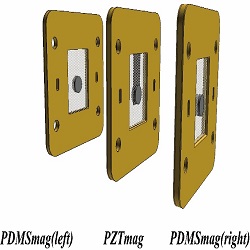
Figure 1: The Schematic of the air breathing pump components of magnetically driven PEMFC stack
Recent Publications:
1. D. Fuard, T. Tzvetkova-Chevolleau, S. Decossas, P. Tracqui, P. Schiavone (2008) Optimization of poly-di-methyl-siloxane (PDMS) substrates for studying cellular adhesion and motility. Microelectronic Engineering 85:1289-1293.
2. A. Ullmann (1998) The piezoelectric valve-less pump—performance enhancement analysis. Sens. Actuators A: Phys. 69:97-105.
3. H.K. Ma, S.H. Huang, B.R. Chen, L.W. Cheng, J (2008) Numerical study of a novel micro-diaphragm flow channel with piezoelectric device for proton exchange membrane fuel cells. Power Sources 180:402-409.
4. H.K. Ma, J.S. Wang, Y.T. Chang, J (2011) Development of a novel pseudo bipolar piezoelectric proton exchange membrane fuel cell with nozzle and diffuser. Power Sources 196:3766-3772.
5. H.K. Ma, H.M. Cheng, W.Y. Cheng, F.M. Fang, W.F. Luo, J (2013) Development of a piezoelectric proton exchange membrane fuel cell stack (PZT-Stack). Power Sources 240:314-322.








